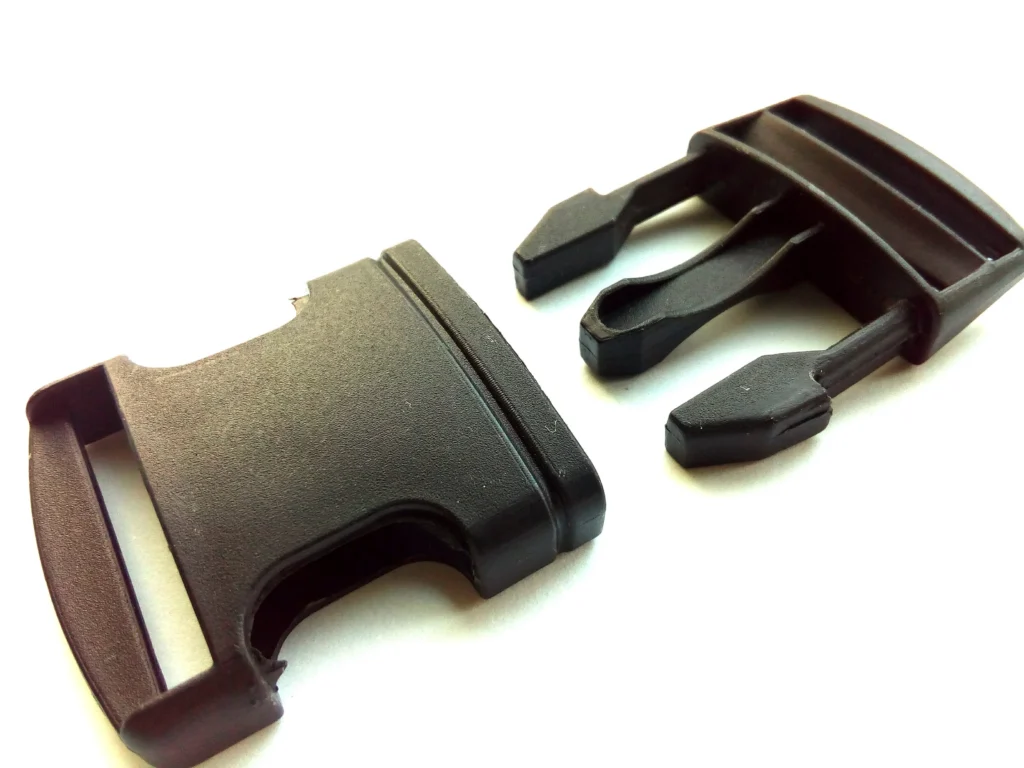Snap fits are one of the best ways to assemble plastic parts without requiring additional components. When parts are designed to be snap-fit together, pushing the parts together will create a reliable connection point without any tooling necessary. However, designing a perfect snap fit is easier said than done.
In this guide, our expert machinists will explain everything you need to know about snap fits. We’ll teach you what they are, why they’re so great, some best practices to consider, and how snap fits stand up to more traditional fastening methods. By the end, you should be able to design snap fits with confidence.
When Snap Fits are Typically Used
Before getting too far, let’s discuss when you might use a snap-fit. Snap fits are commonly used in designs requiring frequent assembly and disassembly. As a simple example, consider the buckle on your backpack. This is a snap fit that allows you to tighten and loosen the straps around your backpack in seconds, instead of unscrewing parts or using tools to do the same action.
Snap fits are particularly effective in products where traditional fastening methods would be impractical. This includes consumer electronics, toys, battery covers, small household items, automotive parts, medical devices, and packaging. These applications benefit from snap fits due to their need for compact design and minimal visible fastening elements.

Advantages of Using Snap Fits in Designs
Why do so many industries use snap fits? This design style has plenty of advantages — let’s look at some of the bigger reasons why you might use snap fits in the first place.
Reducing Material and Labor Costs
Snap fits eliminate the need for additional hardware like screws or adhesives, which significantly cuts down material and labor costs. This is particularly evident in mass-produced items like toys and consumer electronics, where the cost savings can be substantial.
Saving just one penny can quickly add up as you create 100,000 parts for a production run — that penny of savings turns into a savings of $1,000 across the full run.
Simplifying Assembly and End-User Interaction
The ease of assembly with snap fits is a major advantage. Products like mobile phone cases and battery covers can be assembled much faster and without any tools. For the end-user, this translates to ease of use and convenience, as seen in the quick assembly and disassembly of children’s toys.
Aesthetically Pleasing Finish
A good snap fit can easily mask or hide the fastening elements. This makes for a more aesthetically pleasing design. This is crucial in devices like wearables and home appliances, where appearance is as important as functionality.
Best Practices in Designing Snap Fits
To maximize the effectiveness of snap fits, certain design considerations are crucial. The material selection is vital — plastics such as ABS or polycarbonate are popular for their flexibility and strength. The design should allow for enough flex without causing too much stress to the material.
Make sure you use the right tolerances and dimensions between the parts being snapped together. Too much space will create an unreliable assembly, and not enough space will make it way too hard to snap the parts together.
You should also consider the direction of assembly and disassembly, ensuring that the snap fits are accessible and operable.
Snap Fits vs. Other Fastening Methods
As you probably know, snap fits aren’t the only way of connecting two parts together. For plastic parts, you can also consider screws or adhesion/ plastic welding.
Comparison with Screws
Unlike screws, snap fits don’t require the alignment of threads, which makes the assembly process quicker and eliminates the risk of cross-threading. This is especially beneficial in products like electronic housings, where speed and precision are crucial during assembly.
In addition, threading small plastic parts can be really tricky — it requires unreliable threads and small components that can be lost.
Finally, using screws also forces the end user to use tools to disassemble their parts. With snap fits, the two pieces can be separated by hand.
Comparison with Adhesion and Plastic Welding
It’s possible to weld two pieces of plastic together using supersonic welding or plastic welding. Similarly, using an adhesive or epoxy is a way to connect pieces together for long periods of time.
The big downside with this connection method is that you can’t reliably disconnect and reconnect the pieces. In other words, welding or adhering two pieces of plastic together should be considered a permanent bond.
With snap-fits, you can get a snug mate between two parts with the added benefit of being able to disconnect the parts without damaging either component.
Being able to disconnect parts with a snap fit allows you to replace parts, open the assembly, and perform easier maintenance.
Common Examples of Snap Fits in Design
Snap fits are used all around you, and you might interact with a snap fit on a daily basis. Where are these fits commonly found?
We mentioned that plastic buckles use snap fits, but another common example can be found in your living room: the battery compartment of remote controls often utilizes snap fits for easy access.
Similarly, mobile phone cases snap onto phones, providing protection without the use of screws or adhesives.
In automotive interiors, snap fits enable the easy removal and reinstallation of trim pieces for maintenance purposes.
Conclusion
As you learned, snap fits are a great way to connect two parts together without requiring tooling or extensive measures to separate the parts in the future. You can find snap fits in your remote controllers, phone cases, and backpacks.
If you want to create parts that utilize snap fits, consider working with Rapid Axis. We are a full-service machine shop that offers fabrication, assembly, and finishing steps in a variety of different materials. We can create parts that reliably snap fit together for your operation. Get a free quote today.
